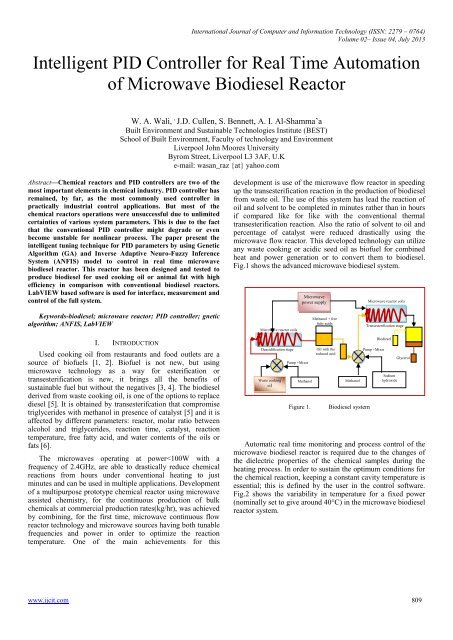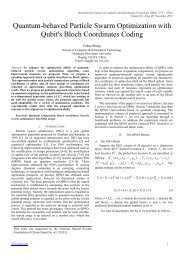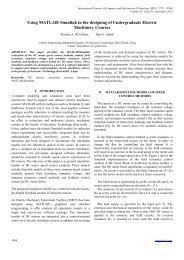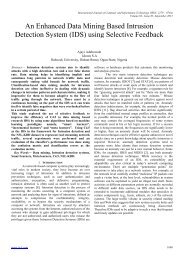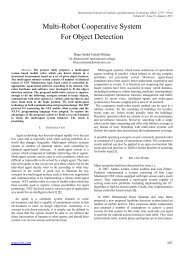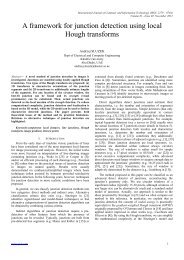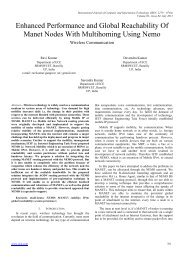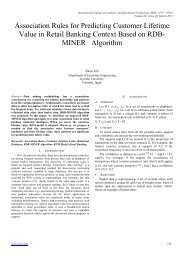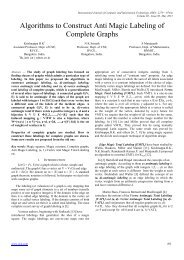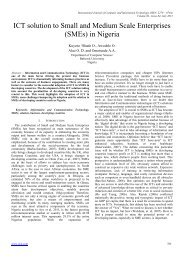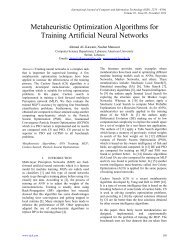Intelligent PID Controller for Real Time Automation of Microwave ...
Intelligent PID Controller for Real Time Automation of Microwave ...
Intelligent PID Controller for Real Time Automation of Microwave ...
You also want an ePaper? Increase the reach of your titles
YUMPU automatically turns print PDFs into web optimized ePapers that Google loves.
International Journal <strong>of</strong> Computer and In<strong>for</strong>mation Technology (ISSN: 2279 – 0764)Volume 02– Issue 04, July 2013<strong>Intelligent</strong> <strong>PID</strong> <strong>Controller</strong> <strong>for</strong> <strong>Real</strong> <strong>Time</strong> <strong>Automation</strong><strong>of</strong> <strong>Microwave</strong> Biodiesel ReactorW. A. Wali, , J.D. Cullen, S. Bennett, A. I. Al-Shamma’aBuilt Environment and Sustainable Technologies Institute (BEST)School <strong>of</strong> Built Environment, Faculty <strong>of</strong> technology and EnvironmentLiverpool John Moores UniversityByrom Street, Liverpool L3 3AF, U.Ke-mail: wasan_raz {at} yahoo.comAbstract—Chemical reactors and <strong>PID</strong> controllers are two <strong>of</strong> themost important elements in chemical industry. <strong>PID</strong> controller hasremained, by far, as the most commonly used controller inpractically industrial control applications. But most <strong>of</strong> thechemical reactors operations were unsuccessful due to unlimitedcertainties <strong>of</strong> various system parameters. This is due to the factthat the conventional <strong>PID</strong> controller might degrade or evenbecome unstable <strong>for</strong> nonlinear process. The paper present theintelligent tuning technique <strong>for</strong> <strong>PID</strong> parameters by using GeneticAlgorithm (GA) and Inverse Adaptive Neuro-Fuzzy InferenceSystem (ANFIS) model to control in real time microwavebiodiesel reactor. This reactor has been designed and tested toproduce biodiesel <strong>for</strong> used cooking oil or animal fat with highefficiency in comparison with conventional biodiesel reactors.LabVIEW based s<strong>of</strong>tware is used <strong>for</strong> interface, measurement andcontrol <strong>of</strong> the full system.development is use <strong>of</strong> the microwave flow reactor in speedingup the transesterification reaction in the production <strong>of</strong> biodieselfrom waste oil. The use <strong>of</strong> this system has lead the reaction <strong>of</strong>oil and solvent to be completed in minutes rather than in hoursif compared like <strong>for</strong> like with the conventional thermaltransesterification reaction. Also the ratio <strong>of</strong> solvent to oil andpercentage <strong>of</strong> catalyst were reduced drastically using themicrowave flow reactor. This developed technology can utilizeany waste cooking or acidic seed oil as bi<strong>of</strong>uel <strong>for</strong> combinedheat and power generation or to convert them to biodiesel.Fig.1 shows the advanced microwave biodiesel system.<strong>Microwave</strong>power supply<strong>Microwave</strong> reactor coilsKeywords-biodiesel; microwave reactor; <strong>PID</strong> controller; gneticalgorithm; ANFIS, LabVIEW<strong>Microwave</strong> reactor coilsMethanol + freefatty acidsTransesterification stageI. INTRODUCTIONUsed cooking oil from restaurants and food outlets are asource <strong>of</strong> bi<strong>of</strong>uels [1, 2]. Bi<strong>of</strong>uel is not new, but usingmicrowave technology as a way <strong>for</strong> esterification ortransesterification is new, it brings all the benefits <strong>of</strong>sustainable fuel but without the negatives [3, 4]. The biodieselderived from waste cooking oil, is one <strong>of</strong> the options to replacediesel [5]. It is obtained by transesterifcation that compromisetriglycerides with methanol in presence <strong>of</strong> catalyst [5] and it isaffected by different parameters: reactor, molar ratio betweenalcohol and triglycerides, reaction time, catalyst, reactiontemperature, free fatty acid, and water contents <strong>of</strong> the oils orfats [6].The microwaves operating at power
International Journal <strong>of</strong> Computer and In<strong>for</strong>mation Technology (ISSN: 2279 – 0764)Volume 02– Issue 04, July 2013Figure 2.Variability in microwave biodiesel reactorFrom Fig.2, we can see the instability in temperaturecontrol due to the sample variability. The control systemshould be able to maintain stability and per<strong>for</strong>mance level inspite <strong>of</strong> uncertainties in the system [7]. An unsuccessfulreaction step due to any changes in the reaction conditions canlead to incomplete conversion or damage to reactor and couldlead to a significant risk. Fig.3 shows the block diagram <strong>of</strong>biodiesel production from waste cooking oil with real timemonitoring and process control.Proportional-integral-derivative (<strong>PID</strong>) controllers are themost widely used controller in practically industrial controlapplications [8- 10] because <strong>of</strong> their simplicity, robustness in awide range <strong>of</strong> operating conditions. To yield satisfactoryresults, the values <strong>of</strong> <strong>PID</strong> parameters must be tuned accordingto the characteristics <strong>of</strong> the process. However, <strong>PID</strong> controlper<strong>for</strong>ms well only at a particular operating range and it isnecessary to retune the <strong>PID</strong> controller if the operating range ischanged. This limitation <strong>of</strong> <strong>PID</strong> control rapidly become evidentwhen applied to more complicated system such as those with atime-delay, poorly damped, nonlinear and time-varyingdynamics. There<strong>for</strong>e, it might degrade or even become unstable<strong>for</strong> nonlinear processes with a range <strong>of</strong> operating conditions[11]. Fig.4 shows unsuccessful experimentations <strong>for</strong> theconventional tuning methods to tune the <strong>PID</strong> parameters on thereal time microwave biodiesel reactor at 30°C requiredtemperature and 300ml/min oil flow rate. Fig.5 show thecontroller cannot reject the disturbance as -20% changes in oilflow rate.Fig.6 shows comparison between fuzzy controller <strong>for</strong> themicrowave biodiesel reactor [12] and the conventional <strong>PID</strong>controller at multi set point tracking (required temperaturebeginning from the nominal temperature value <strong>of</strong> 30°C andchanging rise to35°C then down to 30°C).Virgin oilWaste water problemsWaste cooking oilFigure 4. Unsuccessful tuning <strong>for</strong> <strong>PID</strong> parameters on real timemicrowave biodiesel reactor (at 30°C required temperature)+Sodium HydroxidePumpMethanolTemperature and Oil flow rate SensorsRequired temperature++Inlet oil temperature Inlet oil flow rate--<strong>Controller</strong><strong>Microwave</strong> reactorBiodieselOutlet oiltemperatureSensorsFigure 3.Block diagram <strong>for</strong> biodiesel production and controlFigure 5.Conventional <strong>PID</strong> controller cannot reject the disturbancewww.ijcit.com 810
International Journal <strong>of</strong> Computer and In<strong>for</strong>mation Technology (ISSN: 2279 – 0764)Volume 02– Issue 04, July 2013The selection algorithm chooses individuals <strong>for</strong> reproductionon the basis <strong>of</strong> their relative fitness. To <strong>for</strong>m new <strong>of</strong>fspring thechromosomes are crossed over with crossover probabilityMutation is then applied with determinate probability.The <strong>PID</strong> parameter tuning procedure is described in Fig.7.ANFIS model <strong>for</strong> the system gives all possible in<strong>for</strong>mationabout the plant which is required to tune the <strong>PID</strong> controllergenetically. The online genetic algorithm proved difficult totest due to fact that the simulations cannot be run in real time[20]. GA then is used as <strong>of</strong>fline stage <strong>for</strong> tuning the <strong>PID</strong>parameters based on the ANFIS model which it is has onlineupdating <strong>for</strong> any changes as shown respectively in Fig.8 andFig.9.Figure 6.Comparison between fuzzy controller with conventional <strong>PID</strong>controller <strong>for</strong> microwave biodiesel reactorCreate population: <strong>for</strong> <strong>PID</strong> parametersII.CONTROL SYSTEMThe biodiesel transesterification reaction is one <strong>of</strong> thecomplex and high nonlinear processes. It involves a wide range<strong>of</strong> operating conditions, as several signal and stages interactwith each other. So, the first problem in controller design is thesystem model [13], when controller is to be built withouthaving an accurate mathematical model <strong>of</strong> the system or themathematical model cannot deal with ill-defined and uncertainsystems, then the presence <strong>of</strong> uncertainties can make mismatchbetween the <strong>for</strong>mulated mathematical model and true process,which may degrade the control per<strong>for</strong>mance and would lead toserious stability problems. To solve these problems, theintelligent technique which describes the dynamic behavioroperation by nonlinear structures such as fuzzy systems andneural networks, been adapted [14]. Genetic algorithm is usedto tune the <strong>PID</strong> parameters to be working well at set pointtracking and at disturbance rejection, based on the adaptiveneuro fuzzy inference system (ANFIS) model <strong>for</strong> advancemicrowave biodiesel reactor.A. Adaptive Neuro-Fuzzy Inference System(ANFIS) model<strong>for</strong> microwave biodiesel systemA fuzzy inference system employing fuzzy if-then rules canmodel the qualitative aspects <strong>of</strong> human knowledge andreasoning processes without employing precise quantitativeanalysis [15]. The advanced microwave biodiesel reactor ismodeled by using an ANFIS model [16]. ANFIS is widely usedin complex system studies <strong>for</strong> modeling control or parameterestimating [17-19]. The objective <strong>of</strong> ANFIS is to optimize theparameters <strong>of</strong> given fuzzy inference system by applying alearning procedure using a set <strong>of</strong> input-output training data.B. Genetic Algorithm(GA)Genetic algorithm is guided by the mechanisms <strong>of</strong> threeoperators: reproduction, crossover and mutation. GA initializesby population <strong>of</strong> n randomly encoded chromosomes. Theobjective function <strong>of</strong> generated population is then evaluated.Measure fitness:Which <strong>of</strong> the chromosomes gives a minimum errorvalue between the set point and ANFIS output, bymaking an <strong>of</strong>fline simulation <strong>of</strong> the ANFIS modelwith <strong>PID</strong> controller at these chromosomes valuesFigure 7.(T set)Figure 8.Select fitnessCrossover and mutation between theseselected chromosomes to get another values.Optimum <strong>PID</strong> parametersApply these values on <strong>PID</strong> controller <strong>for</strong> realtime microwave systemTuning algorithm+_errorGA process in microwave biodiesel reactor<strong>PID</strong> <strong>Controller</strong>Control input<strong>Real</strong> <strong>Time</strong> <strong>Microwave</strong>Biodiesel Reactor<strong>PID</strong> <strong>Controller</strong> proceduresOutput Oil temperaturewww.ijcit.com 811
International Journal <strong>of</strong> Computer and In<strong>for</strong>mation Technology (ISSN: 2279 – 0764)Volume 02– Issue 04, July 2013Setpoint +(Tset) _Figure 9.errorGAP, I, D ParametersConventional<strong>PID</strong>-Control<strong>Controller</strong> output<strong>Real</strong> <strong>Time</strong> <strong>Microwave</strong>Biodiesel ReactorANFIS <strong>Microwave</strong> BiodieselReactor ModelOnline updatingOnline errorGenetic tuning algorithm <strong>for</strong> <strong>PID</strong> parameters based on ANFISmodel_ANFIS output (T A)The GA starts with a random population being initialized.This can be easily achieved in LabVIEW using the randomnumber generator as shown in Fig.11. Three randompopulations each <strong>of</strong> the required size were initialized torepresent the proportional gain, derivative gain and the integralgain.The objective function is used to provide a measure <strong>of</strong> howindividuals have per<strong>for</strong>med in the problem domain. In the case<strong>of</strong> a minimization problem, the fit individuals will have thelowest numerical value <strong>of</strong> (E) which is given by (1). TheANFIS model is used to select the fittest individualscorresponding to the lowest values.III.CONTROLLER DESINGThe objective function used in this work is given in (1),(T set ) is the desired reactor temperature (set point), T A is theANFIS output temperature, and T Max , maximum ANFIS output.The GA routine is to minimize this fitness value <strong>of</strong> absoluteerror (E) as in Fig.10.Inlet oil flow rateInlet temperature<strong>Controller</strong> output<strong>PID</strong> <strong>Controller</strong>P, I, D ParametersGeneticallyANFIS BiodieselModel-Out Temp.E=e+eo+essError? MinimumTA, TMAX, TSS (Steady state temperature)Figure 11.VI <strong>for</strong> initial random populationThe crossover operator is mainly responsible <strong>for</strong> the globalsearch property <strong>of</strong> the GA. The basic idea <strong>of</strong> the step is toproduce a new member in the population whose value isdetermined by two parents existing in the population.Crossover was implemented by randomly selecting two entriesand replacing the least fit <strong>of</strong> them by the weighted average <strong>of</strong>the two as shown in Fig.12.Figure 10.Fitness function block diagramE=e+e ss +e o (1)Wheree: error between the setpoint and ANFIS output.e=|T set -TA| (2)e ss : steady state errore ss =lim t e(t) (3)eo: overshoot errore o =|T set -T Max | (4)Figure 12.VI <strong>for</strong> crossoverT Max : Maximum ANFIS output temperaturewww.ijcit.com 812
After crossover is per<strong>for</strong>med, mutation takes place. Themutation operator is used to inject new genetic material into thepopulation. Mutation randomly alters a variable with a smallprobability. The random number generator was used <strong>for</strong> bothrandom selection <strong>of</strong> a member from the current population andto replace it with a new random value as shown in Fig.13.International Journal <strong>of</strong> Computer and In<strong>for</strong>mation Technology (ISSN: 2279 – 0764)Volume 02– Issue 04, July 2013Figure 14.<strong>Intelligent</strong> <strong>PID</strong> controller at multiple setpoint trackingFigure 13.VI <strong>for</strong> mutationVI.EXPERIMENTAL RESULTThe <strong>PID</strong> controller is designed using LabVIEW. The input<strong>of</strong> the controller represents the error between measuredtemperature and set point (required temperature). The output <strong>of</strong><strong>PID</strong> is the control signal applied to the biodiesel plant. Thecontroller working at (5s control sample interval) and(300ml/min flow rate). Fig.14 shows the controllerimplementation as follows:1- <strong>PID</strong> controller was tested to track the set pointbeginning from inlet oil temperature to requiredtemperature equal to 30°C.2- The controller was then subjected to a multiple setpoint tracking beginning from the nominaltemperature value <strong>of</strong> 30°C and changing up to35°C then down to 30°C.Figure 15. Comparison between intelligent <strong>PID</strong> controller andconventional <strong>PID</strong> controller (setpoint equal to 30°C)Fig.15 shows the controller comparison between thegenetically tuning <strong>PID</strong> controller and conventional <strong>PID</strong>controller at set point tracking (required temperature equal to30°C). The disturbance was then introduced. The nominal feedin oil flow rate was reduced by 20% and 10% then rising by30% as shown in Fig.16.Figure 16. Disturbance rejections (change the oil flow rate -20%, -10%,+30%) <strong>for</strong> the <strong>Intelligent</strong> <strong>PID</strong> controllerwww.ijcit.com 813
International Journal <strong>of</strong> Computer and In<strong>for</strong>mation Technology (ISSN: 2279 – 0764)Volume 02– Issue 04, July 2013IV.CONCLUSIONThe <strong>Intelligent</strong> <strong>PID</strong> controller has been developed <strong>for</strong> realtime nonlinear process control (<strong>Microwave</strong> biodiesel reactor).The design method used ANFIS model and GA to realize <strong>PID</strong>tuning parameters. The experimental results illustrate that theproposed controller design gives good control per<strong>for</strong>mance inset point tracking and in disturbance rejection. LabVIEW baseds<strong>of</strong>tware is presented and used <strong>for</strong> tuning and implemented the<strong>PID</strong> control with real time monitoring.REFERENCES[1] T. Thamsiriroj, J. Murphy, “A critical Review <strong>of</strong> the Applicability <strong>of</strong>Biodiesel and Grass Biomethane as Bi<strong>of</strong>uels to Satisfy Both Bi<strong>of</strong>uelTargets and Sustainability Criteria”, Applied Energy, Vol.88, PP.1008-1019, 2011.[2] H. Zhang, Q. Wag, S. Mortimer, “Waste Cooking Oil as an EnergyResource: Review <strong>of</strong> Chinese Policies”, Renewable and SustainableEnergy Reviews, Vol.16, PP.5225-5231, 2012.[3] Andy Kelly, “A Liverpool University Pr<strong>of</strong>essor’s Chip Fat Fuel LeadsPush <strong>for</strong> Cleaner Cars”, Liverpool Daily Post, 25 May 2009.[4] C. Yin, “<strong>Microwave</strong>-Assisted Pyrolysis <strong>of</strong> Biomass <strong>for</strong> Liquid Bi<strong>of</strong>uelsProduction”, Bioresource Technology, Vol.120, PP.273-284, 2012.[5] T. Benavides, U. Diwekar, “Optimal Control <strong>of</strong> Biodiesel Production inBatch Reactor Part I: DEeterministic Control”, Fuel, Vol. 49, PP:211-217, 2012.[6] Y. Shen, J. Cheng, J. Ward, C. Yu, “ Design and Control <strong>of</strong> BiodieselProduction Process with Phase Split and Recycle in the ReactorSystem”, Journal <strong>of</strong> the Taiwan Institute <strong>of</strong> chemical Engineering,Vol.42, PP:741-750, 2011.[7] G. Zames, B. Francis, “Feedback Minimax Sensitivity and OptimalRobustness”, IEEE Transactions on Automatic Control, Vol. 28, PP.585-601, 1983.[8] L. Santos, M. Wicth<strong>of</strong>fpessoa, “A Tuning Strategy <strong>for</strong> Multivariable PIand <strong>PID</strong> <strong>Controller</strong>s Using Differential Evolution Combined with ChaticZaslavkii Map”, Expert Systems With Applications, Vol.38, PP.13694-13701, 2011.[9] C. Huang, L. Xie, Y. Liu, “PD plus Error-Dependent Integral Nonlinear<strong>Controller</strong>s <strong>for</strong> Robot Manipulators with an uncertain Jacobian Matrix”,ISA Transaction. Vol.51, PP.792-800, 2012.[10] S. Yang, “A New Anti-Windup Strategy <strong>for</strong> <strong>PID</strong> <strong>Controller</strong>s withDerivative Filters”, Asian Journal <strong>of</strong> Control, Vol.14, PP.564–571, 2012.[11] N. Kamala, “Multivariable control <strong>of</strong> Nonlinear Process using S<strong>of</strong>tComputing Techniques”, Journal <strong>of</strong> Advances in In<strong>for</strong>mationTechnology, Vol. 3, 2012.[12] W. Wali, J. Cullen, S. Bennett, K. Hassan, A. Shaw, A.I. Al Shamma’a,“Fuzzy Logic <strong>Controller</strong> <strong>of</strong> Advanced <strong>Microwave</strong> Biodiesel Reactor”,5th Annual Liverpool BEAN Conference, 2010. ISBN: 978-0-9562747-3-1.[13] Gonzalez, Yu Tang, “Black-Box Identification <strong>of</strong> a Class <strong>of</strong> NonlinearSystems by a Recurrent Neur<strong>of</strong>uzzy Network”, IEEE Transaction onNeural Networks, VOL.21, PP.672-679, 2010.[14] Glan Devadhas. G, Pushpakumar. S., “<strong>Intelligent</strong> <strong>Controller</strong> Design <strong>for</strong> aChemical Process”, International Journal <strong>of</strong> Engineering, (IJE), VOL.4PP.399-410, 2010.[15] S. Hwang, S. Chun Chan, S. Chin Hsieh, Cheng-Yu Li, “Photonic<strong>Microwave</strong> Generation and Transmission using Direct Modulation <strong>of</strong>Stably Injection-locked Semiconductor Lasers”, OpticsCommunications, Vol.284, PP.3581-3589, 2011.[16] W.A. Wali, A.I. Al-Shamma’a, Kadhim H. Hassan, J.D. Cullen, “OnlineGenetic-ANFIS Temperature Control <strong>for</strong> Advanced <strong>Microwave</strong>Biodiesel Reactor”, Journal <strong>of</strong> Process Control, Vol. 22, PP. 1256–1272, 2012.[17] S. Soyguder, and H. Alli, “An Expert System <strong>for</strong> the Humidity andTemperature Control in HVAC Systems using ANFIS and Optimizationwith Fuzzy Modeling Approach,” Energy and Buildings, Vol. 41,PP.814-822, 2009.[18] S. Khuntia, S. Panda, “Simulation Study <strong>for</strong> Automatic GenerationControl <strong>of</strong> a Multi-Area Power System by ANFIS Approach”, AppliedS<strong>of</strong>t Computing, Vol.12, PP.333-341, 2012.[19] M. Bagheri, M. Rajabi, M. Mirbagheri, M. Amin, “BPSO-MLR andANFIS Based Modeling <strong>of</strong> Lower Flammability Limit”, Journal <strong>of</strong> LossPrevention in the Process Industries, Vol.25, PP.373-382, 2012.[20] P.J. Fleming, R.C. Purshouse, “Genetic Algorithms in Control SystemsEngineering”, in: Proceedings <strong>of</strong> the 12th IFAC World Congress, 2001.www.ijcit.com 814


